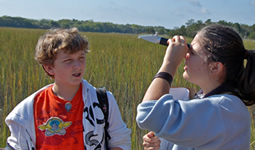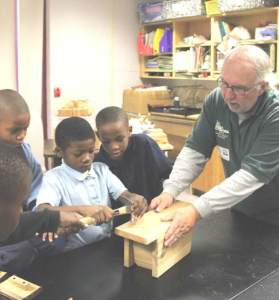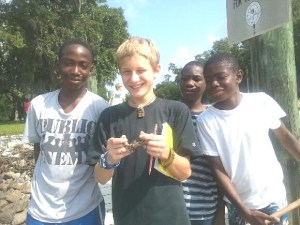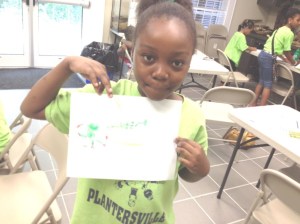Environmental Education: New Programs and New Partnerships
Environmental education was the primary motivation for founding the SEWEE Association in 1997. Although we have come to support other important projects for our partners, like loggerhead sea turtle recovery efforts and shorebird conservation, our board has always understood the value of and need for strong environmental education in our schools, and that the future needs knowledgeable, engaged, and motivated citizens making decisions to continue to protect the valuable ecosystems of our national forest and wildlife refuges.
Where we’ve been … Although we offer a myriad of programs including one-day excursions and a variety of scientific investigation lessons covering topics ranging from reptiles, red wolves, and swallow-tailed kites to water quality and climate change, for 16 years our Earth Stewards program has been the cornerstone of our environmental education efforts.
Earth Stewards, initially developed in conjunction with the US Fish & Wildlife Service, is a ten week, standards-based curriculum which utilizes the plethora of natural resources provided by our national wildlife refuges and national forest to engage elementary and middle school students in real outdoor science investigations. Students begin by getting out of the classroom and onto the refuges and forest to investigate and collect data on freshwater wetlands. Then, throughout the year we build on the knowledge gained from the initial investigation with field trips and in-class lessons about the flora and fauna of our local ecosystems. The data students collect (along with data from ongoing research projects on the refuges and forest) is used to give real world connections to the math, science, and critical thinking skills that they are learning in their classrooms.
Overall, we strive to provide students an experience that will not only reinforce understanding of their science and math requirements, but also stimulate their curiosity and inspire them to ask questions about the world and its inhabitants.
In a time when we, as a society, are increasingly disconnected from our natural resources, the experiences our programs provide may be one of the only opportunities many of our kids have to make a meaningful connection with nature. Moreover, with an increased emphasis on math and science education our programs provide teachers with a host of important tools to augment students’ “textbook learning” of math and science.
When we began providing education programs about the ecosystems of Cape Romain National Wildlife Refuge and the Francis Marion National Forest at the Sewee Visitor and Environmental Education Center in 1997 we reached about 75 students a year in our first two years. Today we reach over 14,000 students a year all along the South Carolina coast and have added Waccamaw and E.F. Hollings ACE Basin National Wildlife Refuges as partners. Our growth has been due to one teacher telling another about our programs. We think this is the best testament to the value of our offerings.
Where we’re going … As with nature we are always striving to adapt; always working to keep our curricula timely and improve our teaching techniques. In 2012 we began adapting and updating many of our lessons: adding new student-led investigations, service learning projects and field excursions, incorporating more technology (blogs, apps, and tablets, Oh my?), and integrating the new South Carolina science standards.
Arguably the most exciting change has been our partnership with Coastal Expedition’s South Carolina Outdoors Education Program (SCOEP) which gives many of our Earth Stewards students the chance to investigate Bulls Island as a conclusion to their field studies program! As a result of this tremendous opportunity our main theme has shifted to comparing the biodiversity of the freshwater wetlands of the Francis Marion National Forest and rivers of Waccamaw National Wildlife Refuge to the maritime habitats of Cape Romain.
Throughout the program students will be using all sorts of scientific field sampling techniques to investigate water quality and document the organisms in these distinct habitats. Students will make food webs out of the photographs we take in the field, learn to calculate the biodiversity (yes, math is actually useful in the real world!), and discover how scientists use biodiversity to assess the health of an ecosystem. Students will also be updating our new Earth Stewards blog throughout the year with pictures of the cool stuff they encounter, interesting facts they’ve uncovered, and reflections on their experiences (it will be linked on Facebook so please check it out and see what we’re up to!).
Our mission at Friends of Coastal South Carolina has always been to bring science out of the classroom and awaken the innate curiosity for the natural world that we believe exists in all people!




